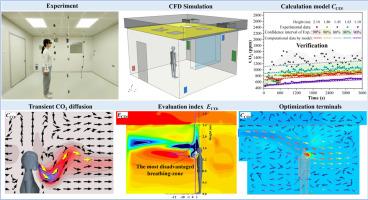用于个人空气质量和冷暖系统需求控制通风的CO2瞬态扩散新指标和模型
IF 7.6
1区 工程技术
Q1 CONSTRUCTION & BUILDING TECHNOLOGY
引用次数: 0
摘要
二氧化碳(CO 2)浓度评价指标和预测方法在需求控制通风(DCV)优化中起着至关重要的作用。然而,污染源对个人空气质量(PAQ)中CO2瞬态分布的非均匀性影响往往被忽视。本研究旨在提出一种新的当量CO2指数(ECO₂)和计算CO2浓度(CCO₂)模型来研究瞬态CO2扩散。该方法定义了单位时间内均匀混合参考浓度,精确定位CO2富集最不利呼吸区的背景指数,以及不同高度呼出CO2的校正系数;该模型包括每小时换气量(ACH)、乘员特征、温度、压力梯度、二氧化碳呼出率、污染物扩散持续时间以及不同呼吸区高度的校正因子。通过对实验结果和计算流体力学(CFD)模拟结果的分析,研究了冷热系统不同顶棚和侧壁末端的CO2瞬态扩散规律。验证了瞬态CFD模拟和计算模型对不同呼吸区高度下CO2浓度的有效预测。在不稳定的动力气流系统下,CO2分布主要受垂直对流/热羽流控制。吊顶制冷不同高度的CO2浓度差异最小,平均ECO₂值较高。在稳定的热分层系统下,顶棚采暖促进污染物水平扩散。此外,根据个人需求优化设计方案,平均正ECO₂增加了4.9%。该研究量化了来自污染源的非均匀二氧化碳分布,从而实现了基于paq的预测和通风优化。本文章由计算机程序翻译,如有差异,请以英文原文为准。

New index and model of transient CO2 diffusion for personal air quality and demand-controlled ventilation in heating and cooling systems
Evaluation metrics and prediction methods for carbon dioxide (CO₂) concentration play a critical role in Demand–Controlled Ventilation (DCV) optimization. However, the non–uniform impact of pollution sources on transient CO2 distribution in personal air quality (PAQ) is frequently overlooked. This study aims to propose a new equivalent CO2 index (ECO₂) and a computational CO2 concentration (CCO₂) model to investigate transient CO2 diffusion. This method defines uniformly mixed reference concentration per unit time, background index for pinpointing the most disadvantaged breathing-zone with excessive CO2 accumulation, and the correction factor for exhaled CO2 at different heights; the model consists of air changes per hour (ACH), characteristics of occupant, temperature, pressure gradients, CO2 exhaled rates, pollutant diffusion duration, and correction factor for varying breathing–zone heights. Transient CO2 diffusion patterns for various ceiling and sidewall terminals of heating and cooling systems were investigated through analyzing experimental and computational fluid dynamics (CFD) simulation results. Transient CFD simulation and the computation model were validated for effective prediction of CO2 concentrations at varying breathing–zone heights. Under the unstable dynamic airflow system, CO2 distribution was primarily governed by vertical convection/thermal plumes. The ceiling cooling has the smallest CO2 concentration difference at different heights, which has a higher average ECO₂ value. Under the stable thermally stratified system, the ceiling heating promoted horizontal pollutant diffusion. Moreover, the average positive ECO₂ had increased by 4.9 % by optimizing the design scheme based on individual demand. This investigation quantifies non-uniform CO2 distributions from pollution sources, enabling PAQ-based prediction and ventilation optimization.
求助全文
通过发布文献求助,成功后即可免费获取论文全文。
去求助
来源期刊

Building and Environment
工程技术-工程:环境
CiteScore
12.50
自引率
23.00%
发文量
1130
审稿时长
27 days
期刊介绍:
Building and Environment, an international journal, is dedicated to publishing original research papers, comprehensive review articles, editorials, and short communications in the fields of building science, urban physics, and human interaction with the indoor and outdoor built environment. The journal emphasizes innovative technologies and knowledge verified through measurement and analysis. It covers environmental performance across various spatial scales, from cities and communities to buildings and systems, fostering collaborative, multi-disciplinary research with broader significance.
 求助内容:
求助内容: 应助结果提醒方式:
应助结果提醒方式:


